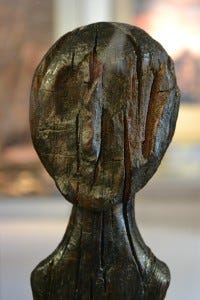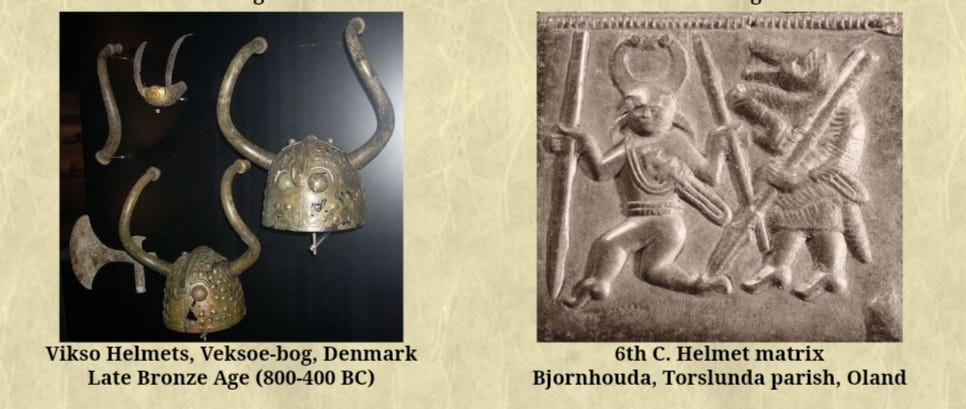Odin Is Far Older Than Most Sources Admit.
When you research how old Odin / Wotan is, you get a mixed bag of answers. It's time for some clarity.
Without a doubt, most pagan folk have searched the Internet with similar queries, and gotten similar results. A runic carving on a C-bracteate (pendant) that is is dated to somewhere around 420 AD, and it's dating is justified by saying that, this is the oldest item found with a Runic inscription mentioning Odin / Wotanaz. It was found in Denmark in 2020. That is not only deceptive, but it is also applies piss poor logic to judge the age of a Deity that was worshipped by most of Europe, and in areas as far east as what is now modern Russia, and Ukraine, for well over 2,500 years.
When we really want to know how old the veneration of Odin, Wotan, or Wodanaz is, we also need to look at things like statues and carvings. Dating these things by using only runes, does not paint a true picture. So, with that being said, you may be surprised with the locations where some of these items were found. Which in my opinion, is equally as surprising as when they were created, and eventually were buried, or in some cases grown over and simply reclaimed by nature.
Let's dive in.
The Oldest Artifacts
The first one that comes to mind is a one eyed idol carved from a piece of scots pine. It was found not far from the bank of the Thames river. The conditions of the boggy ground preserved this wooden idol in a way that sand, and dry soil never could have. In fact, the finding a wooden idol this old, and almost fully intact, shocked the world, then we were shocked again when it was dated. Why you ask? Well, this particular artifact is roughly 4,000 years old, and it was found under roughly 9 feet of peat. This idol perfectly depicts several known aspects of Odin. From Wikipedia, to the Smithsonian, they all seem to agree.
This is how the 4,000 year old figure, with no left eye, and a detachable penis is described on Wikipedia “ The statue is made of Scots pine and stands 18 inches (46 cm) high. It has two legs but no arms; hips and buttocks narrowing to a waist and then broadening to shoulders; and a rounded head. There are straight markings cut across both legs. A hole in the pubic region can be interpreted as indicating a female, but with the insertion of a phallic peg (now lost) would indicate a male. There appears to be damage to the left eye… the damage is similar to Odin's sacrifice of an eye at Mímir's Well in return for wisdom in Norse myth.”
The fact that this statue is either missing, or was intentionally carved with a damaged left eye, is a significant indicator of “who” this was meant to depict. Then when you add the fact that there is a socket for a replaceable / detachable penis, and there isn't a doubt left in my mind, that this is a depiction of Odin / Wotan. Before anyone asks, yes it is a well established and well known fact, that Odin was also worshipped among most of the known pre-Christian Anglo, and Saxon tribes of England.


This particular artifact is currently the oldest known depiction of Odin / Wotan, but there are hundreds of others that also date to well before the year 0 mark. From helmets, to images carved into wood or stone, the pantheon of Gods known as the Aesir and Vanir go much farther back in history than 420 AD. As I stated earlier, it is quite disingenuous for some clearly biased academics to date them using only their names carved in runes.
In all of the research that has been put into this particular topic, most of it seems to point to Germanic tribes having the oldest evidence. From England, and modern day Germany, these tribes all seem to share some of the oldest representations of the Aesir. While the oldest depictions of Frey and Freya in particular appear to originate from Jutland, an area that borders Northern Germany, and Denmark. Most of these artifacts date to a few centuries later.
The small peninsular area Jutland, where the two modern countries Germany, and Denmark meet, seems to be a hot spot for artifacts. Known now as Schleswig-Holstein, Germany, on the southern portion of the peninsula, we see a great number of pre-Christian, pagan artifacts that are discovered here. This is also the very same area where some of the first blending of genetically modern humans, and neanderthals happened, and they eventually began to mingle, hybridize, and interbreed. This is the cradle of human civilization, at least in regards to the ancestors of European folks, and further back in time with the Indo-European people. This is also where some of the oldest known musical instruments, and also the oldest carvings of an idol appear to have happened.
So given these facts, I find it really hard to believe that Iraq is the cradle of human civilization, or that the worship of Wotan / Odin only dates back to 420 AD.
Thank you all for reading. It is only because of curious folks like you, that questions like these will ever get answered. Just think, some schools are still teaching kids that Mesopotamia was the cradle of human civilization roughly 5,500 years ago. A fact that was disproven well over a century ago, but for some reason, it is still being fed to people in the public school system.
Break the narrative, and look at the facts.
Links and Sources :
https://dispatchesfromtheformernewworld.com/2016/06/02/the-dagenham-idol/
https://www.landofthefannslearning.org/archaeology/the-dagenham-idol/
https://en.m.wikipedia.org/wiki/Dagenham_idol
https://www.thomasdanegallery.com/artists/43-michael-landy/works/16026/
https://www.germanicmythology.com/works/EARLYART.html
https://www.germanicmythology.com/works/MISCELLANEOUSART.html








So given these facts, I find it really hard to believe that Iraq is the cradle of human civilization, or that the worship of Wotan / Odin only dates back to 420 AD.
The cradle of life was probably Anatolia, Turkey, not Iraq.
https://www.youtube.com/watch?v=SBywa_sZgj0&t=213s